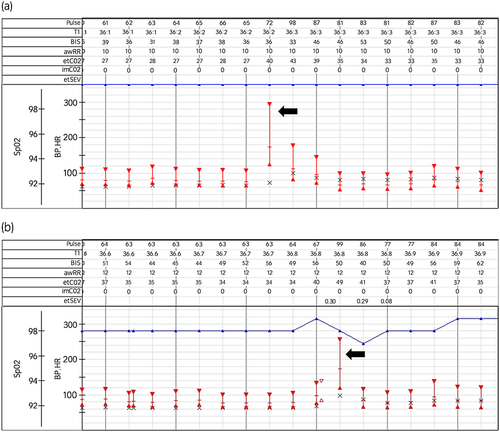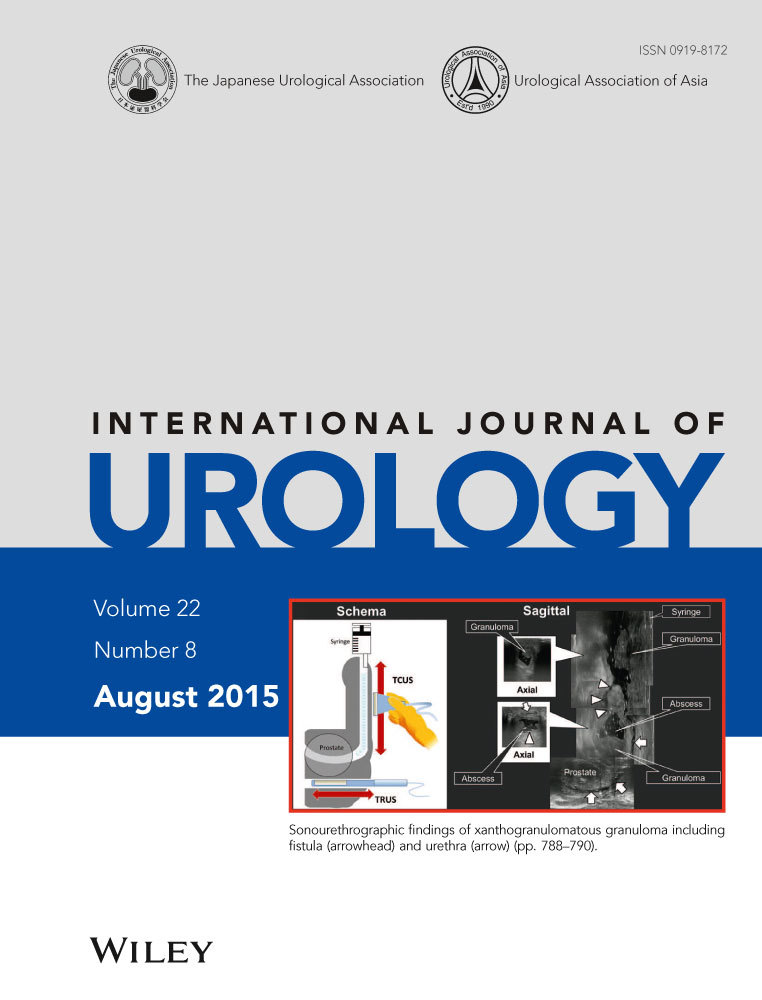Hypertensive crisis during hemostasis of adrenal bleeding using a soft-coagulation device
Abbreviations & Acronyms
-
- awRR
-
- airway respiration rate
-
- BIS
-
- bispectral index
-
- BP
-
- blood pressure
-
- etCO2
-
- end-tidal carbon dioxide
-
- etSEV
-
- end-tidal sevoflurane
-
- HR
-
- heart rate
-
- imCO2
-
- inspired minimum carbon dioxide
-
- SpO2
-
- percutaneous oxygen saturation
-
- T1
-
- temperature 1 (rectal temperature)
Electrocautery is a common procedure that is used to control bleeding from surgical sites. A soft-coagulation device that reduces parenchymal bleeding during thoracic, hepatic and pancreatic surgeries,1-3 and urological surgeries such as partial nephrectomy4 recently became available. Our experience using the device in the Department of Urology, The University of Tokyo, Tokyo, Japan since 2010 has proven its usefulness for ameliorating peri- and postoperative hemorrhage from operated kidneys. However, we experienced two cases of intraoperative hypertensive crisis that were possibly caused by soft-coagulation of the adrenal gland. Hypertensive crisis is a condition defined as a systolic blood pressure exceeding 180 mmHg or a diastolic blood pressure exceeding 120 mmHg. It is further classified as a hypertensive urgency and hypertensive emergency. The former condition involves minimal organ damage or its absence, whereas the latter causes irrevocable damage in vital organs.5 In the present study, we describe our experience.
The first case involved a 66-year-old man with left ureteral cancer. He had a current medical history of type 2 diabetes mellitus and a smoking habit of 20 cigarettes per day for 46 years. His blood pressure on admission was 155/58 mmHg and he was taking no antihypertensive drugs. During nephroureterectomy in March 2014, we encountered hemorrhage from the adrenal gland and coagulated the bleeding site using an I/O electrical rod connected to a monopolar SOFT COAG system (VIO 300D; ERBE Elektromedizin GmbH, Tübingen, Germany) with 80 W and Effect 7. Normal saline solution was continuously dripped onto the site by the soft-coagulation device. When we electrocauterized the adrenal gland for 5 s, the patient's blood pressure immediately increased to 300/110 mmHg (Fig. 1a). The anesthesiologist promptly injected phentolamine 2 mg intravenously, and the patient's blood pressure returned to the baseline level in a few minutes.

The second case involved a 67-year-old man with left renal pelvic cancer. He had a current medical history of type 2 diabetes mellitus, atrial fibrillation and a smoking habit of 40 cigarettes per day for 47 years. He previously underwent total gastrectomy for gastric cancer in August 2013. He received treatment for mild essential hypertension with amlodipine 5 mg daily, which he discontinued in July 2013. His blood pressure at admission was 129/85 mmHg. He underwent laparoscopic nephroureterectomy in April 2014. The adrenal gland was accidentally lacerated in an attempt to expose the gland, and thus, we coagulated the gland electronically using the same system for approximately 10 s. The patient's blood pressure surged to 270/105 mmHg (Fig. 1b). Nicardipine hydrochloride 2 mg was intravenously injected and the crisis diminished.
Fransson et al. reported hypertensive crisis during radiofrequency ablation of normal adrenal tissue in dogs. The target temperature in the study was set at 60–105 °C. During radiofrequency ablation, systolic blood pressure increased above 200 mmHg in four of five dogs, and the median plasma norepinephrine concentration increased by 39-fold versus baseline. They reported that adrenal thermal damage might result in a catecholamine-induced hypertensive crisis.6 In our patients, there was no direct evidence of an association between norepinephrine release and intraoperative hypertension crisis. However, it is highly probable that catecholamines released from the adrenal gland by electrocautery were responsible for the crisis. We presume that electrocautery using a monopolar soft-coagulation device could allow an even larger amount of catecholamines to drain into the blood. The temperature of the surgical site coagulated by the SOFT COAG system is regulated at below the boiling point of water,1 whereas the decomposition temperature of norepinephrine is approximately 191 °C.7 To our knowledge, the association between electrocautery for bleeding from the normal adrenal gland using simple monopolar or bipolar coagulation devices and hypertensive crisis has not been well studied. We typically use those devices for bleeding from the normal adrenal gland; however, we have never experienced hypertensive crisis. In October 2012, AMCO Inc. (Tokyo, Japan), an import distributor of VIO 300D equipment in Japan, released a safety booklet for the surgical system.8 Of 10 cases of adrenal ablation during hepatectomy, hypertensive crisis occurred in seven cases. The median peaks of systolic blood pressure and heart rate during hypertensive crisis were reported as 200 mmHg (range 168–319 mmHg) and 90 b.p.m. (range 68–114 b.p.m.). These cardiovascular responses appear to be weaker than those in cases of pheochromocytoma, particularly the heart rate responses. The causal association between soft-coagulation of the adrenal gland and hypertensive crisis should be investigated more thoroughly in an animal study. To understand the discrepant cardiovascular responses between patients with pheochromocytoma and our patients, the relationship between the amount and types of catecholamines drained into the blood and cardiovascular responses during the ablation should be investigated.
In conclusion, it should be stressed that adrenal hemostasis using a soft-coagulation device might result in hypertensive crisis. Until the safety of the soft-coagulation device for adrenal hemostasis is assured, we should avoid using this device for intraoperative adrenal gland bleeding.
Conflict of interest
None declared.




